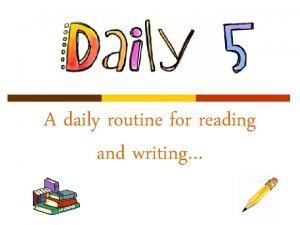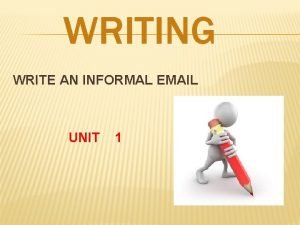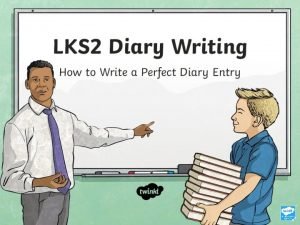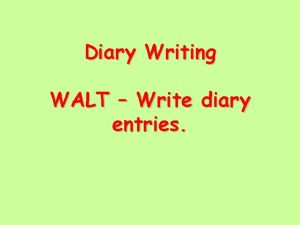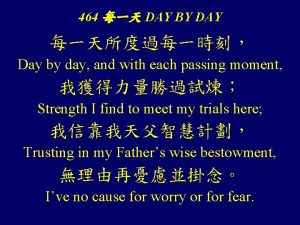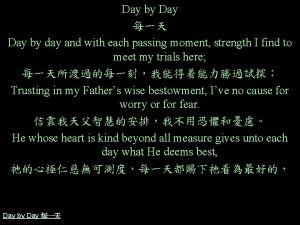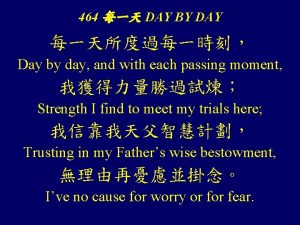Daily Reading and Writing Overview Reading Writing Day











- Slides: 11

Daily Reading and Writing - Overview Reading Writing Day 1 Story time – book of the week Daily sentence writing from picture Day 2 Read and match Which mini beast is your favourite? Day 3 Tricky (red) words. Daily sentence writing from picture Day 4 True or false? Daily sentence writing from picture Butterfly Day Silly questions Superhero writing I set a challenge on the day you are in school (Butterfly Day) or for an extra home learning day. Notes • Butterfly Day is the children’s allocated day in school (for those children who are returning). Days 1 -4 can be used in any order, to support home learning on the other days. For children who are at home for s parent all week, Butterfly Day can be used alongside Days 1 -4, in any order.

Day 1 – Reading Read ‘The Teeny Weeny Tadpole’. If you don’t have a copy of the story at home you can use the link below. https: //www. youtube. com/watch? v=DFzqv. He. XXQw


Day 2 – Reading Can you read these words and decide if they are treasure (real words) or rubbish (nonsense words)? Real words Nonsense words

. ? Which mini beast is your favourite? Why? Day 2 – Writing Can you list some mini beasts? _________________________________________ Can you write a sentence about one of them? _________________________________________________________________________________________________

Day 3 – Reading Keep practising these tricky words. Try the first group, and then move onto the other ones if you need more challenge. You can read them on here, or make up a game. For example, write the words on paper and then place them around the room. Follow an instruction, such as… hop to she … jump to they. I to they all my we was going go he said are the she of you Notes • At school, we call tricky words ‘Red Words’. They are tricky because they cannot be sounded out using phonics, so we need to remember them by sight. This will help to increase the children’s sight for s parent vocabulary and the speed with which they read (fluency).


Day 4 – Reading With help from an adult or older brother / sister, read these sentences about ‘The Teeny Weeny Tadpole’ then decide if they are true or false? Thumbs up for ‘True’ and thumbs down for false. v Mummy frog jumped high into the air. v The Teeny Weeny Tadpole met lots of animals as he swam down the river. v The big bad fish eats worms. v The Teeny Weeny tadpole turned into a frog and jumped higher than anyone else. s Note • If the children are able to use their phonics to read some words, that’s great. However, because the purpose of this activity is to focus on their understanding of the story for s parent (comprehension), it is fine if someone reads the sentences to them. true false


Butterfly Day – Reading Can you read these silly questions, using your phonics? They are so silly, because the answer is very obviously Yes or No. Remember to look at each word to see if you know it straight away. If not, look for special friends and then sound out and blend each word. Black questions focus on Set 1 sounds. The ones in green focus on Set 2, with the odd Set 3 sound. Can a frog jump? Are there 20 days in a week? Has a dog got wings? Does a chair have legs? Can a fish skip? • Notes • for s parent Is a plant made of glass? By answering Yes or No, the children demonstrate if they have understood the question (comprehension). For longer words, e. g. ‘reading’, we ‘chop it up’, so that they sound out and blend the first part of the word and then the rest. Some children may recognise the word ending (suffix) ‘ing’ straight away, without sounding it out. yes no

. ? Butterfly Day – Writing If you could be any minibeast which one would you be and why? Remember to write in full sentences, using finger spaces between each word. Notes • The children will probably spell things the way they sound, using the sounds they know. For example, if they choose to write ‘snail’ they may spell it ‘snayl’. for s parent
 Day 1 day 2 day 3 day 4
Day 1 day 2 day 3 day 4 Day 1 day 2 day 817
Day 1 day 2 day 817 Pre reading while reading and post reading activities
Pre reading while reading and post reading activities Reading daily routine
Reading daily routine Romeo juliet
Romeo juliet Introduction for informal email
Introduction for informal email Example of diary
Example of diary In which person should a diary entry be written?
In which person should a diary entry be written? William beanes elementary
William beanes elementary Oceans apart day after day
Oceans apart day after day Day to day maintenance
Day to day maintenance Physical science chapter 6 review answers
Physical science chapter 6 review answers



